
Columbidae is a bird family consisting of doves and pigeons. It is the only family in the order Columbiformes. These are stout-bodied birds with short necks and short slender bills that in some species feature fleshy ceres. They primarily feed on plants, and can be taxonomically divided amongst granivores, that feed mostly on the ground on seeds, and frugivores, that feed mostly on fruits, from branches. The family occurs worldwide, often in close proximity with humans, but the greatest variety is in the Indomalayan and Australasian realms.
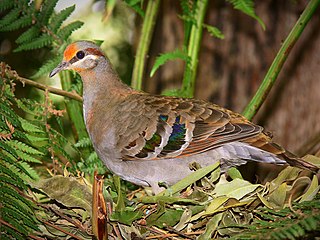
The bronzewing pigeons are a group of pigeons native to Australia which have distinctive iridescent wing patches that appear bronze or green-brown in dull light, but flash in many bright colours in the sun as the bird moves. Three species are always known as "bronzewings" in the genus Phaps, and several broadly similar birds also have the trademark wing patch to a more or less obvious degree. Bronzewings are ground feeders, but are capable of very fast flight. They tend to browse quietly until disturbed, then remain still, their earthy browns blending into the earth and leaf litter until the intruder approaches too closely, when the bronzewings take off with an explosive burst of sudden wing clapping and feather noise, and disappear from sight within moments.

The spotted dove or eastern spotted dove is a small and somewhat long-tailed pigeon that is a common resident breeding bird across its native range on the Indian subcontinent and in East and Southeast Asia. The species has been introduced to many parts of the world and feral populations have become established.

The laughing dove is a small pigeon that is a resident breeder in Africa, the Middle East, South Asia, and Western Australia where it has established itself in the wild after being released from Perth Zoo in 1898. This small long-tailed dove is found in dry scrub and semi-desert habitats where pairs can often be seen feeding on the ground. It is closely related to the spotted dove which is distinguished by a white and black chequered necklace. Other names include laughing turtle dove, palm dove and Senegal dove while in Asia the name little brown dove is often used.
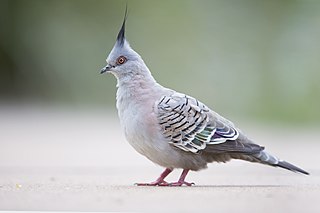
The crested pigeon is a bird found widely throughout mainland Australia except for the far northern tropical areas. Only two Australian pigeon species possess an erect crest, the crested pigeon and the spinifex pigeon. The crested pigeon is the larger of the two species. The crested pigeon is sometimes referred to as a topknot pigeon, a common name shared with the reddish crested Lopholaimus antarcticus of Eastern Australia.

The spinifex pigeon, also known as the plumed-pigeon or gannaway pigeon, is one of three endemic Australian bird species within the genus Geophaps. It occurs within a broader group known as bronzewing pigeons. This species is listed under the International Union for Conservation of Nature (IUCN) Red List category of "least concern". It most frequently occurs in arid and semi-arid habitats containing hummock-forming grasses of the genera Triodia and Plectrachne.

Phaps is a genus of bronzewing pigeons in the family Columbidae that are native to Australia.

The topknot pigeon is a pigeon native to eastern Australia.
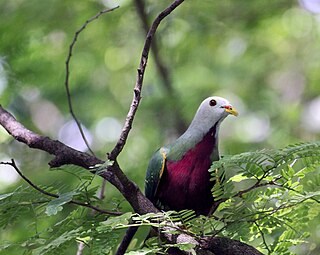
The wompoo fruit dove, also known as wompoo pigeon and "magnificent fruit dove" among others, is one of the larger fruit doves native to New Guinea and eastern Australia.

The common bronzewing is a species of medium-sized, heavily built pigeon. Native to Australia and one of the country's most common pigeons, the common bronzewing is able to live in almost any habitat, with the possible exception of very barren areas and dense rainforests. Its advertising call is an extraordinary mournful whooo repeated at metronomic intervals.

Ducula is a genus of the pigeon family Columbidae, collectively known as imperial pigeons. They are large to very large pigeons with a heavy build and medium to long tails. They are arboreal, feed mainly on fruit and are closely related to the other genus of fruit-eating doves, Ptilinopus. Both genera display brightly coloured plumage, predominantly green, often with contrasting under-parts of purple, orange or red. Some Ducula have prominently swollen ceres. They have large gapes and swallow seeds whole, playing an important role in seed dispersal.

The squatter pigeon is a species of bird in the family Columbidae. It is endemic to northeastern Australia. According to Australia's then Department of the Environment and Energy, the nominate subspecies, southern squatter pigeon is listed as vulnerable. It lives in arid and semi-arid areas, including grasslands and dry sclerophyll forests.

The partridge pigeon is a species of bird in the family Columbidae. It is endemic to Australia.

Geotrygon is a bird genus in the pigeon and dove family (Columbidae). Its members are called quail-doves, and all live in the Neotropics. The species of this genus have ranges from southern Mexico and Central America to the West Indies and South America. Quail-doves are ground-dwelling birds that live, nest, and feed in dense forests. They are remarkable for their purple to brown coloration with light-and-dark facial markings.
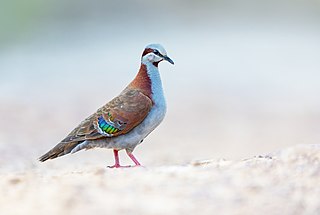
The brush bronzewing is a species of bird in the pigeon family, Columbidae. It is endemic to Australia, with two biogeographically distinct subspecies.
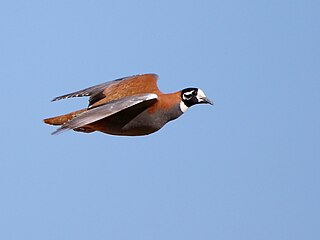
The flock bronzewing, also known as the flock pigeon, harlequin bronzewing and the harlequin pigeon is a species of pigeon in the family Columbidae. It is endemic to drier parts of Australia.

The blue-headed quail dove, or blue-headed partridge-dove, is a species of bird in the pigeon and dove family Columbidae. It is monotypic within the subfamily Starnoenadinae and genus Starnoenas.

Columbinae is a subfamily of birds from the family Columbidae. Otherwise, four genera Geotrygon, Leptotila, Starnoenas and Zenaida form subfamily Leptotilinae.
Primophaps schoddei is an extinct genus and species of bird in the pigeon family. It was described from Late Oligocene material found at Riversleigh in north-western Queensland, Australia. It was closely related to the Australian bronzewing pigeons, especially those in the genus Phaps. The genus name comes from the Latin primordium,, and the Greek phaps (“pigeon”). The specific epithet honours Australian taxonomist Richard Schodde for his work on the relationships of Australian birds.
























